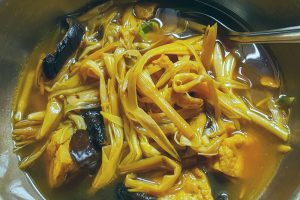
![]() Dear Bonnie, I hear your frustration and I empathize with you. This may be surprising, but some veterinary institutions have allowed TCVM to infiltrate their curriculum with Chinese folk medicine approaches, including “food therapy”. These diets are based not on the vitamins, protein, carbohydrates, and fats they contain but instead assessed based on arcane notions of “energetics” of food. The energetics of TCVM diets are not kilocalories as one might expect, but Yin, Yang, Heat, Cold, Damp, and other unscientific metaphors drawn from a prescientific era. As such, diets are not developed for specific nutritional requirements or to address modern medical diagnoses, but instead on balancing the Yin-ness or Yang-ness of the animal. And how does a TCVM practitioner determine the Yin-Yang balance of a patient such as Bennett? This is where the tongue and pulse “diagnosis” came in. Chinese medicine holds that one should recommend food, herbs, and acupuncture based on the “pattern differentiation” — a composite of signs and symptoms — that relies heavily on the highly subjective impressions of the tongue and pulse. Keep in mind that there is no rigorous, scientific, evidential support for tongue and pulse diagnosis in people or animals, and yet these methods are used to guide treatment. Furthermore, there is little to no research on which to base putting a dog such as Bennett on a Chinese food therapy diet that supposedly calms the Fire in his Lower Burner. If you do try out the diet that the TCVM veterinarian recommended, I’d be interested to know if you saw any changes. Even though TCVM diets are lacking in research, modern veterinary mainstream diets have their own sets of problems, including the presence of excessive carbohydrates, contamination, overcooking, vitamin imbalances, and questionable food quality. There’s definitely room for improvement in many areas of veterinary nutrition.
Dear Bonnie, I hear your frustration and I empathize with you. This may be surprising, but some veterinary institutions have allowed TCVM to infiltrate their curriculum with Chinese folk medicine approaches, including “food therapy”. These diets are based not on the vitamins, protein, carbohydrates, and fats they contain but instead assessed based on arcane notions of “energetics” of food. The energetics of TCVM diets are not kilocalories as one might expect, but Yin, Yang, Heat, Cold, Damp, and other unscientific metaphors drawn from a prescientific era. As such, diets are not developed for specific nutritional requirements or to address modern medical diagnoses, but instead on balancing the Yin-ness or Yang-ness of the animal. And how does a TCVM practitioner determine the Yin-Yang balance of a patient such as Bennett? This is where the tongue and pulse “diagnosis” came in. Chinese medicine holds that one should recommend food, herbs, and acupuncture based on the “pattern differentiation” — a composite of signs and symptoms — that relies heavily on the highly subjective impressions of the tongue and pulse. Keep in mind that there is no rigorous, scientific, evidential support for tongue and pulse diagnosis in people or animals, and yet these methods are used to guide treatment. Furthermore, there is little to no research on which to base putting a dog such as Bennett on a Chinese food therapy diet that supposedly calms the Fire in his Lower Burner. If you do try out the diet that the TCVM veterinarian recommended, I’d be interested to know if you saw any changes. Even though TCVM diets are lacking in research, modern veterinary mainstream diets have their own sets of problems, including the presence of excessive carbohydrates, contamination, overcooking, vitamin imbalances, and questionable food quality. There’s definitely room for improvement in many areas of veterinary nutrition.
All this being stated, I would also recommend considering a veterinary acupuncture appointment with a science-based integrative medical practitioner. Boosting Bennett’s self-regulatory capacity through neurophysiologic changes brought about by medical acupuncture may help reduce inflammation and discomfort in the gastrointestinal tract. Look in our “Find a Practitioner” area of the website for a veterinary medical acupuncturist near you.